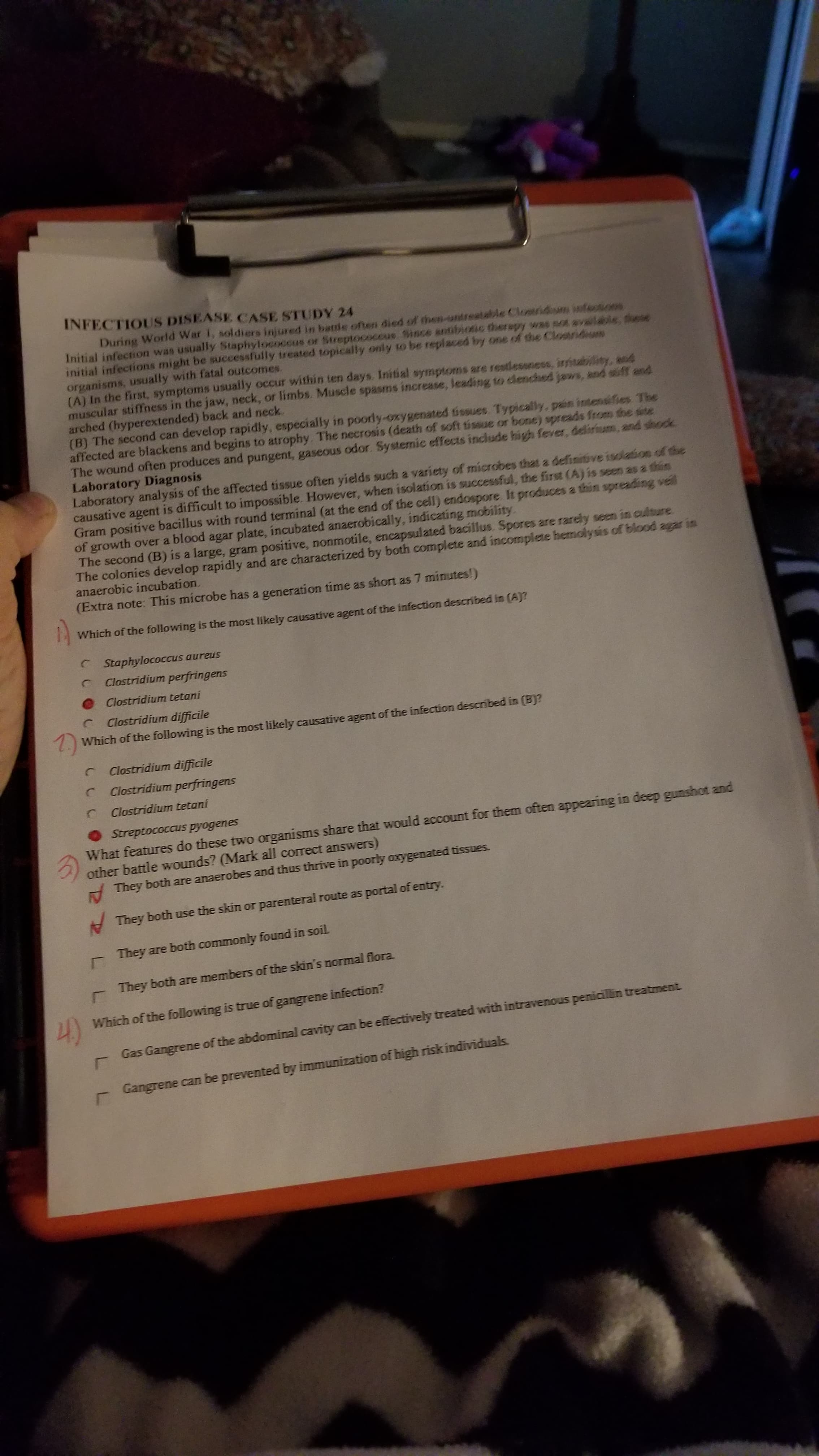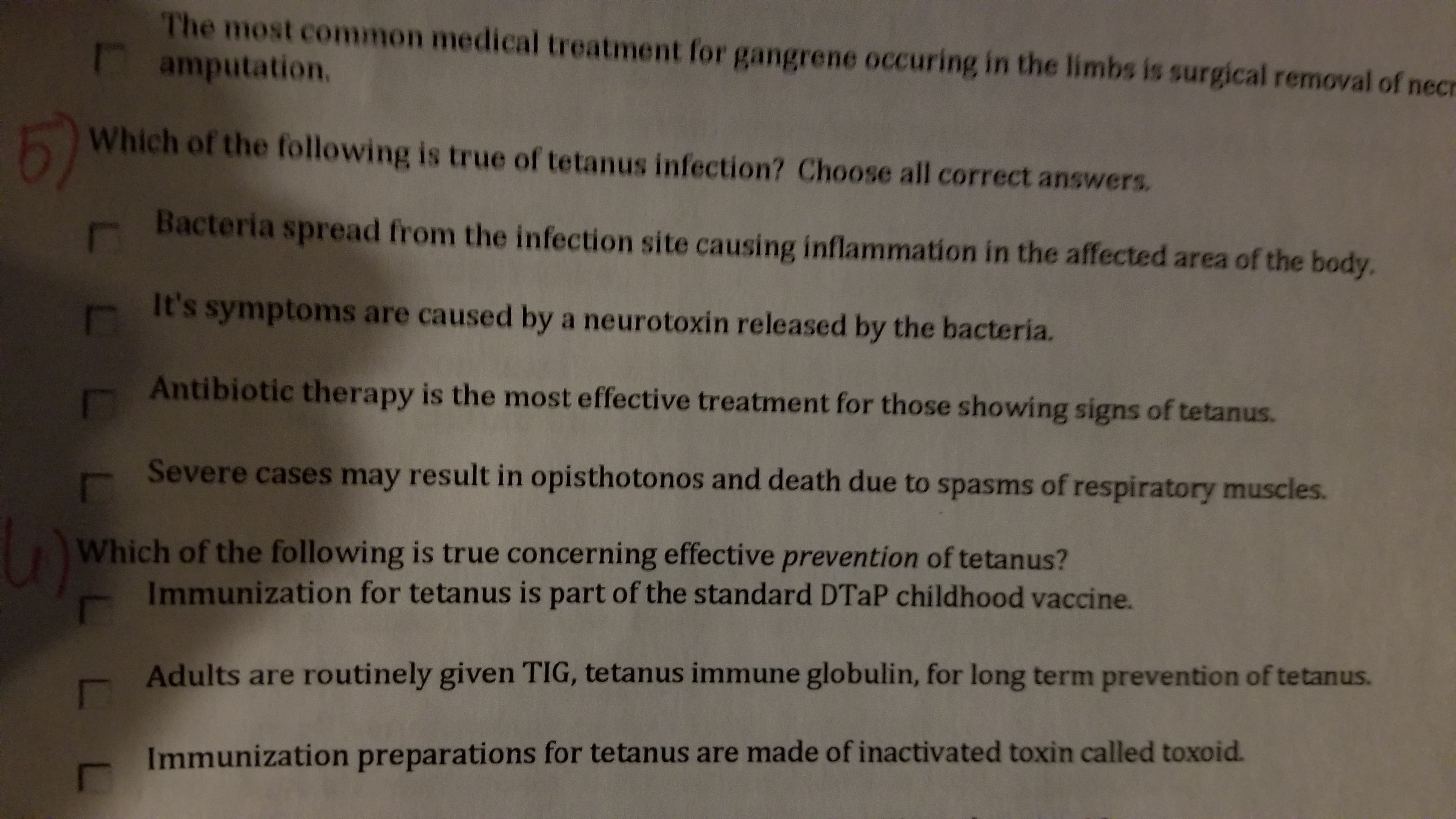INFECTIOUS DISEASE CASE STUDY 24 During World War I, soldiers injured in battde often died of then-untreatable Cluetridism infestions Initial infection was usually Staphylococcus or Streptococee Since antibiotic therapy was sos available tese initial infections might be successfully treated topically only to be replaced by one of the Clootridium organisms, usually with fatal outcomes. (A) In the first, symptoms usually occur within ten days. Initial symptoms are restlessness, inisability, and muscular stiffness in the jaw, neck, or limbs. Muscle spasms increase, leading to clenched jaws, and stiff and arched (hyperextended) back and neck. (B) The second can develop rapidly, especially in poorly-oxygenated tissues. Typically, pain intensifies The affected are blackens and begins to atrophy The necrosis (death of soft tissue or bone) spreads from the site The wound often produces and pungent, gaseous odor. Systemic effects include high fever, delirium, and shock Laboratory Diagnosis Laboratory analysis of the affected tissue often yields such a variety of microbes that a definitive isolation of the causative agent is difficult to impossible. However, when isolation is successful, the first (A) is seen as a thin Gram positive bacillus with round terminal (at the end of the cell) endospore It produces a thin spreading vell of growth over a blood agar plate, incubated anaerobically, indicating mobility. The second (B) is a large, gram positive, nonmotile, encapsulated bacillus. Spores are rarely seen in culture. The colonies develop rapidly and are characterized by both complete and incomplete hemolysis of blood agar in anaerobic incubation. (Extra note: This microbe has a generation time as short as 7 minutes!) Which of the following is the most likely causative agent of the infection described in (A)? C Staphylococcus aureus CC lostridium perfringens Clostridium tetani Clostridíum difficile 7) Which of the following is the most likely causative agent of the infection described in (B)? Clostridium difficile Clostridium perfringens Clostridium tetani Streptococcus pyogenes What features do these two organisms share that would account for them often appearing in deep gunshot and other battle wounds? (Mark all correct answers) They both are anaerobes and thus thrive in poorly oxygenated tissues. A They both use the skin or parenteral route as portal of entry. They are both commonly found in soil. They both are members of the skin's normal flora. 4) Which of the following is true of gangrene infection? Gas Gangrene of the abdominal cavity can be effectively treated with intravenous penicillin treatment Gangrene can be prevented by immunization of high risk individuals. The most common medical treatment for gangrene occuring in the limbs is surgical removal of necr amputation, 5) Which of the following is true of tetanus infection? Choose all correct answers. Bacteria spread from the infection site causing inflammation in the affected area of the body. It's symptoms are caused by a neurotoxin released by the bacteria. Antibiotic therapy is the most effective treatment for those showing signs of tetanus. Severe cases may result in opisthotonos and death due to spasms of respiratory muscles. Which of the following is true concerning effective prevention of tetanus? Immunization for tetanus is part of the standard DTaP childhood vaccine. Adults are routinely given TIG, tetanus immune globulin, for long term prevention of tetanus. Immunization preparations for tetanus are made of inactivated toxin called toxoid.
INFECTIOUS DISEASE CASE STUDY 24 During World War I, soldiers injured in battde often died of then-untreatable Cluetridism infestions Initial infection was usually Staphylococcus or Streptococee Since antibiotic therapy was sos available tese initial infections might be successfully treated topically only to be replaced by one of the Clootridium organisms, usually with fatal outcomes. (A) In the first, symptoms usually occur within ten days. Initial symptoms are restlessness, inisability, and muscular stiffness in the jaw, neck, or limbs. Muscle spasms increase, leading to clenched jaws, and stiff and arched (hyperextended) back and neck. (B) The second can develop rapidly, especially in poorly-oxygenated tissues. Typically, pain intensifies The affected are blackens and begins to atrophy The necrosis (death of soft tissue or bone) spreads from the site The wound often produces and pungent, gaseous odor. Systemic effects include high fever, delirium, and shock Laboratory Diagnosis Laboratory analysis of the affected tissue often yields such a variety of microbes that a definitive isolation of the causative agent is difficult to impossible. However, when isolation is successful, the first (A) is seen as a thin Gram positive bacillus with round terminal (at the end of the cell) endospore It produces a thin spreading vell of growth over a blood agar plate, incubated anaerobically, indicating mobility. The second (B) is a large, gram positive, nonmotile, encapsulated bacillus. Spores are rarely seen in culture. The colonies develop rapidly and are characterized by both complete and incomplete hemolysis of blood agar in anaerobic incubation. (Extra note: This microbe has a generation time as short as 7 minutes!) Which of the following is the most likely causative agent of the infection described in (A)? C Staphylococcus aureus CC lostridium perfringens Clostridium tetani Clostridíum difficile 7) Which of the following is the most likely causative agent of the infection described in (B)? Clostridium difficile Clostridium perfringens Clostridium tetani Streptococcus pyogenes What features do these two organisms share that would account for them often appearing in deep gunshot and other battle wounds? (Mark all correct answers) They both are anaerobes and thus thrive in poorly oxygenated tissues. A They both use the skin or parenteral route as portal of entry. They are both commonly found in soil. They both are members of the skin's normal flora. 4) Which of the following is true of gangrene infection? Gas Gangrene of the abdominal cavity can be effectively treated with intravenous penicillin treatment Gangrene can be prevented by immunization of high risk individuals. The most common medical treatment for gangrene occuring in the limbs is surgical removal of necr amputation, 5) Which of the following is true of tetanus infection? Choose all correct answers. Bacteria spread from the infection site causing inflammation in the affected area of the body. It's symptoms are caused by a neurotoxin released by the bacteria. Antibiotic therapy is the most effective treatment for those showing signs of tetanus. Severe cases may result in opisthotonos and death due to spasms of respiratory muscles. Which of the following is true concerning effective prevention of tetanus? Immunization for tetanus is part of the standard DTaP childhood vaccine. Adults are routinely given TIG, tetanus immune globulin, for long term prevention of tetanus. Immunization preparations for tetanus are made of inactivated toxin called toxoid.
Essentials of Pharmacology for Health Professions
7th Edition
ISBN:9781305441620
Author:WOODROW
Publisher:WOODROW
Chapter17: Anti-infective Drugs
Section: Chapter Questions
Problem 1CRQ
Related questions
Question
#5: first page is just the info. #5 is on page two

Transcribed Image Text:INFECTIOUS DISEASE CASE STUDY 24
During World War I, soldiers injured in battde often died of then-untreatable Cluetridism infestions
Initial infection was usually Staphylococcus or Streptococee Since antibiotic therapy was sos available tese
initial infections might be successfully treated topically only to be replaced by one of the Clootridium
organisms, usually with fatal outcomes.
(A) In the first, symptoms usually occur within ten days. Initial symptoms are restlessness, inisability, and
muscular stiffness in the jaw, neck, or limbs. Muscle spasms increase, leading to clenched jaws, and stiff and
arched (hyperextended) back and neck.
(B) The second can develop rapidly, especially in poorly-oxygenated tissues. Typically, pain intensifies The
affected are blackens and begins to atrophy The necrosis (death of soft tissue or bone) spreads from the site
The wound often produces and pungent, gaseous odor. Systemic effects include high fever, delirium, and shock
Laboratory Diagnosis
Laboratory analysis of the affected tissue often yields such a variety of microbes that a definitive isolation of the
causative agent is difficult to impossible. However, when isolation is successful, the first (A) is seen as a thin
Gram positive bacillus with round terminal (at the end of the cell) endospore It produces a thin spreading vell
of growth over a blood agar plate, incubated anaerobically, indicating mobility.
The second (B) is a large, gram positive, nonmotile, encapsulated bacillus. Spores are rarely seen in culture.
The colonies develop rapidly and are characterized by both complete and incomplete hemolysis of blood agar in
anaerobic incubation.
(Extra note: This microbe has a generation time as short as 7 minutes!)
Which of the following is the most likely causative agent of the infection described in (A)?
C Staphylococcus aureus
CC lostridium perfringens
Clostridium tetani
Clostridíum difficile
7)
Which of the following is the most likely causative agent of the infection described in (B)?
Clostridium difficile
Clostridium perfringens
Clostridium tetani
Streptococcus pyogenes
What features do these two organisms share that would account for them often appearing in deep gunshot and
other battle wounds? (Mark all correct answers)
They both are anaerobes and thus thrive in poorly oxygenated tissues.
A They both use the skin or parenteral route as portal of entry.
They are both commonly found in soil.
They both are members of the skin's normal flora.
4)
Which of the following is true of gangrene infection?
Gas Gangrene of the abdominal cavity can be effectively treated with intravenous penicillin treatment
Gangrene can be prevented by immunization of high risk individuals.

Transcribed Image Text:The most common medical treatment for gangrene occuring in the limbs is surgical removal of necr
amputation,
5)
Which of the following is true of tetanus infection? Choose all correct answers.
Bacteria spread from the infection site causing inflammation in the affected area of the body.
It's symptoms are caused by a neurotoxin released by the bacteria.
Antibiotic therapy is the most effective treatment for those showing signs of tetanus.
Severe cases may result in opisthotonos and death due to spasms of respiratory muscles.
Which of the following is true concerning effective prevention of tetanus?
Immunization for tetanus is part of the standard DTaP childhood vaccine.
Adults are routinely given TIG, tetanus immune globulin, for long term prevention of tetanus.
Immunization preparations for tetanus are made of inactivated toxin called toxoid.
Expert Solution
This question has been solved!
Explore an expertly crafted, step-by-step solution for a thorough understanding of key concepts.
This is a popular solution!
Trending now
This is a popular solution!
Step by step
Solved in 3 steps

Knowledge Booster
Learn more about
Need a deep-dive on the concept behind this application? Look no further. Learn more about this topic, biology and related others by exploring similar questions and additional content below.Recommended textbooks for you

Essentials of Pharmacology for Health Professions
Nursing
ISBN:
9781305441620
Author:
WOODROW
Publisher:
Cengage


Essentials of Pharmacology for Health Professions
Nursing
ISBN:
9781305441620
Author:
WOODROW
Publisher:
Cengage
